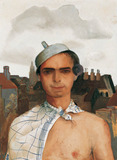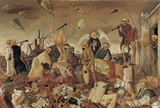Felix Nussbaum
Die fortwährende Suche nach Ruhe und einem neuen Vaterland nahm meine ganze Zeit in Anspruch. Nirgends wohnhaft zog ich umher mit hastig notierten Aquarellen zusammengerollt im Gepäck... Schweiz, Frankreich, Paris..., bis sich endlich die Grenze zu Belgien erlösend öffnete. In Ostende begann ich wieder zu arbeiten, zeichnete und malte fleißig. Ich wehre mich und werde nicht müde. Es geht.
[The ongoing search for tranquillity and a new homeland took up all my time. Never at home, I moved around with hastily made watercolours rolled up in my pack... Switzerland, France, Paris..., until the border to Belgium finally opened itself to my relief. In Ostende I started working again, drew and painted a lot. I am resisting and I will not tire. It's ok. (ed. trans.)]
Felix Nussbaum in an article by the Belgian art critic Emile Langui in the Flemish newspaper Vooruit, 5 February 1939
| Born | on 11 December 1904 in Osnabrück, Germany |
|---|---|
| Died | Date of death unknown, Auschwitz-Birkenau, Poland |
| Exile | Italy, France, Belgium |
| Profession | Painter |
Through art, Felix Nussbaum assured himself of his identity, which had been repeatedly thrown into question for him through his years of exile. He dealt with the experiences of losing his homeland and persecution directly in his pictures. In spite of these drastic themes, many of the works he produced while in exile display a subtle humour.
After his art studies in Berlin, in 1932 Nussbaum received a scholarship to the renowned Deutsche Akademie Rom in the Villa Massimo. While in Italy, Nussbaum received news of the assumption of power by the Nazis. He would never return to Germany. This was followed by a period of frequent changes of location, during which he always carried all of his pictures with him. With his cargo, the painter emigrated to Belgium via France in 1935. For Nussbaum, the years in Belgium, in which he failed to receive a work permit, were marked by financial hardship and the daily anxieties of exile. At the same time, the period was among the most artistically productive in his life. After the German invasion of Belgium in 1940, Nussbaum was interned in the St. Cyprien camp in southern France. He managed to escape and return to Brussels, where he went into hiding at an art dealer's with whom he was friends. In his hiding place he painted works that dealt with his experience in the camp, with fear, desperation and looming arrest. On 20 June 1944, Nussbaum was arrested after being denounced and on 31 July 1944 was deported to Auschwitz, where he was murdered. The exact date of death is unknown, but it is assumed that Nussbaum died in Auschwitz between September 20, 1944 and January 27, 1945.
Selected works:
Im Lager (1940)
Der Sturm (1941)
Le Soir (1942)
Selbstbildnis mit Judenpass (1943)
Triumph des Todes (1944)
Further reasing:
Bergner, Eva: Felix Nussbaum. Verfemte Kunst – Exilkunst – Widerstandskunst. Die wichtigsten 100 Werke. Bramsche: Rasch Verlag 1990
Junk, Peter / Zimmer, Wendelin: Felix Nussbaum. Leben und Werk. Köln: Du Mont 1982
Zerull, Ludwig: Felix Nussbaum. Hannover: Verlag TH. Schäfer 1998




